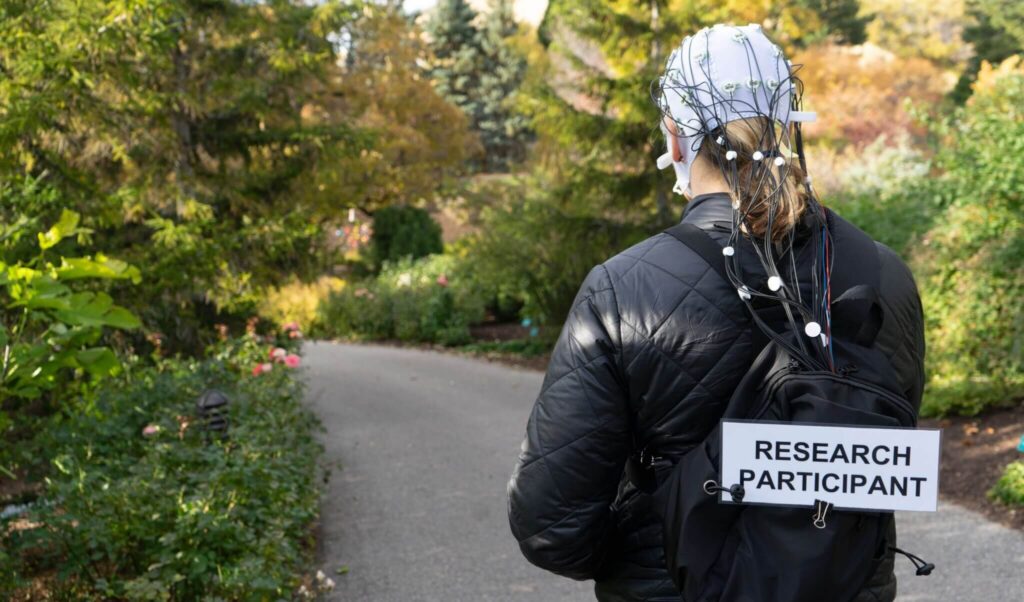
Walking in Nature can Restore Brain’s Ability to Pay Attention
By John Anderer
While great American authors like Whitman and Thoreau have been telling us for centuries that nature can soothe the soul and heal the heart, new research finds a walk in green spaces may be just as revitalizing for the brain. Scientists from the University of Utah say their latest project, conducted in the University’s Red Butte Garden using electroencephalography (EEG), reveals that walking in nature can help restore a person’s attention span.
An EEG records electrical activity in the brain using small discs attached to the scalp. In this way, researchers measured participants’ attentional capacity after either walking through nature or a parking lot.
“A walk in nature enhances certain executive control processes in the brain above and beyond the benefits associated with exercise,” the study authors report in a media release.
These findings are just the latest in a growing body of scientific literature related to how natural settings contribute to and benefit human physical and mental health. The University of Utah recently established a new research group, Nature and Human Health Utah, that focuses on exploring these topics and developing potential solutions for solving the human-nature divide.
Natural Blaze is Google-Free — We Need Your Support
Contribute Just $1 Per Month at Patreon to Aid the Cause of Health Freedom
Many scientists hypothesize that humans have a primal need for nature baked into their DNA, and diminishing access to nature is putting everyone’s health at risk.
“There’s an idea called biophilia that basically says that our evolution over hundreds of thousands of years has got us to have more of a connection or a love of natural living things,” says Strayer, a professor of psychology, in a media release. “And our modern urban environment has become this dense urban jungle with cell phones and cars and computers and traffic, just the opposite of that kind of restorative environment.”
Prof. Streyer’s prior work focusing on multitasking and distracted driving associated with cellphone use has previously attracted national attention. Over the course of the past decade, his lab has been working on studying how nature affects cognition. This latest study, meanwhile, was part of study co-author Amy McDonnell’s dissertation as a grad student in Strayer’s Applied Cognition Lab. Since then, she has completed her PhD and continues to research attention as a postdoctoral fellow with the University of Utah.
This study took place between April and October 2022 and saw an analysis take place encompassing EEG data recorded amongst 92 participants immediately before and after taking a 40-minute walk. Half of those people walked through Red Butte, the arboretum in the foothills just east of the university. The other half walked through the nearby asphalt-laden medical campus.
“We start out by having participants do a really draining cognitive task in which they count backwards from 1,000 by sevens, which is really hard,” McDonnel notes. “No matter how good you are at mental math, it gets pretty draining after 10 minutes. And then right after that, we give them an attention task.”
The research team intended to deplete participants’ attentional reserves before performing the standardized “Attention Network Task” and taking the walk. Importantly, the walks included no electronic devices, and participants didn’t talk to anyone while on their strolls. Everyone was randomly selected to either walk through the least built-up part of the arboretum along Red Butte Creek or through the adjacent U medical campus and parking lots. However, both possible routes covered precisely two miles and had similar levels of elevation gain.
“The participants that had walked in nature showed an improvement in their executive attention on that task, whereas the urban walkers did not, so then we know it’s something unique about the environment that you’re walking in,” McDonnell comments. “We know exercise benefits executive attention as well, so we want to make sure both groups have comparable amounts of exercise.”

A research participant strolls through Red Butte Garden in 2022 as part of the attention study. PHOTO CREDIT: AMY MCDONNELL
Researchers explain that what sets this study apart from existing research focusing on the human-nature nexus is its reliance on EEG data in particular, as opposed to surveys or self-reporting, which can be highly subjective.
“This is probably one of the most rigorous studies in terms of controlling for and making sure that it’s really the exposure in Red Butte” resulting in the observed cognitive effects, Prof. Strayer adds.
McDonnell fitted each and every participant with a cap with holes to support a total of 32 electrodes contacting the scalp with the help of a specialized gel.
“It has electrodes that are placed all over the surface of the scalp,” Prof. Strayer continues. “It records really very, very small voltages, but it’s an active electrode system that provides beautiful brain maps.”
The maps showed three key components of attention; alerting, orienting, and executive control. Executive control takes place in the brain’s prefrontal cortex, an area known to be critical to working memory, decision-making, problem-solving, and coordinating disparate tasks.
“The kinds of things that we do on an everyday basis tend to heavily use those executive attentional networks,” Prof. Strayer says. “It’s important in concentration and especially, so it’s an essential component of higher order thinking.”
The EEG and attention task results did not reveal much of a difference regarding alertness and orientation between the garden and the asphalt walkers. However, people who went on the nature walk showed improved executive control. Researchers hope further work will eventually reveal which kinds of natural settings result in optimal cognitive benefits, as well as how much exposure is necessary to help.
“If you understand something about what’s making us mentally and physically healthier, you could then potentially engineer our cities so that they supported that,” Prof. Strayer notes.
Study authors are continuing their research at Red Butte, but for now are focusing on how cellphone use affects the garden walkers’ responses. Prof. Strayer is sometimes asked why he studies both distraction and attention, but he sees the two topics as opposing sides of the same coin.
“It’s where the prefrontal cortex is overloaded, overstimulated, and you make all kinds of dangerous mistakes when you’re multitasking behind the wheel,” Strayer concludes. “But the antidote to that is being out in a natural environment, leave the phone in your pocket and then go out and walk the trails. The parts of the brain that have been overused during the daily commute are restored. You see and think more clearly.”
The study is published in Scientific Reports.
You might also be interested in:
Source: Study Finds
John considers himself a pretty nice guy, and an even better writer. He is admittedly biased, though.
Top image: Pexels






